
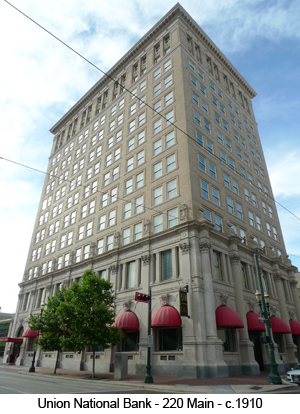
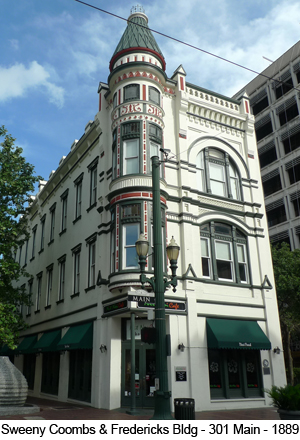
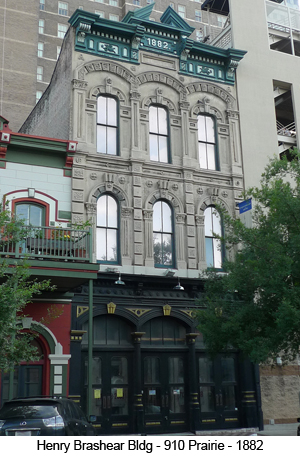
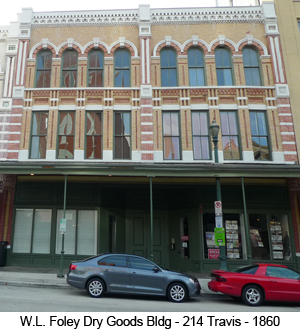
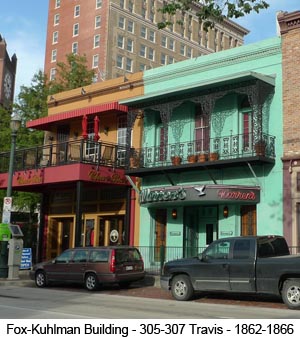
Main Street Market Square
History and Culture
Main Street Market Square was designated as an historic district in 1997. It was listed on the National Register of Historic Places in 1983. The district is Houston’s largest, most intact group of physical resources that represents the city’s civic and commercial history. Its architecture reflects Houston’s development between 1860 and 1950.
Significant Buildings and Sites
Main Street Aqueduct, a reinforced-concrete bridge of150 feet in length, was the longest span in Texas when it was built in 1913. It crossed Buffalo Bayou and was equipped with benches, planting boxes, and restrooms.
Allen’s Landing (park) was the site of Houston’s earliest steamboat landing. It is named for the Allen brothers, who founded the city. Allen’s Landing includes a grassy park and a circular paved overlook above Buffalo Bayou.
Market Square (park) was the site of four of Houston’s City Markets and City Halls. It has been a park since 1976.
Kennedy Bakery Building (813 Congress), is named for John Kennedy, an Irish immigrant who operated bakeries at several other locations before building this one around 1860. This is one of the oldest buildings in Houston still on its original site.
Magnolia Brewery/Ballroom (715 Franklin) by H. C. Cooke & Co., architects, in 1912. This building expanded the Houston Ice and Brewing Company’s Magnolia Brewery complex to both sides of Buffalo Bayou.
Magnolia Brewery Building (110 Milam), adjacent to the Ballroom on Franklin, housed the Houston Ice and Brewing Company’s executive offices, as well as a tap room and the Magnolia Café.
Commercial National Bank (917 Franklin), is a six-story Beaux Arts office building constructed in 1904 by the architects Green and Svarz. Its striking limestone façade curves around the corner from Franklin to Main Street.
Union National Bank Building (220 Main) The St. Louis architects Mauran, Russell, and Crowell were often associated with Houston businessman Jesse Jones, who hired them to design this building, constructed between 1910–1912.
Sweeney, Coombs & Fredericks Building (301 Main), built in 1889 and designed by George E. Dickey, is one of Houston’s few remaining Victorian-era commercial buildings.
Sterne Building (300 Main), by Finger and Bailey, architects; constructed between 1914–1916 as a retail and office building.
Stuart Building (304 Main), constructed between 1879-1880, is a single building with three unique storefronts.
Sweeney and Coombs Building (310 Main), Eugene T. Heiner, architect. This building was constructed in 1880 for the Sweeney & Coombs jewelry company, which moved across the street in 1890. This building has housed music stores, offices, clothing shops, and (for about 10 years) the YWCA. It was restored in the 1990s.
Scanlan Building (405 Main), 1907–1909, by D. H. Burnham & Company, architects, of Chicago. At 11 stories, this was briefly the tallest building in Houston. It was developed as office space and occupied the site where Sam Houston resided while President of Texas.
Barringer-Norton Building (506 Main), a clothing store built in 1928 and designed by architect James Buskin Bailey. Bailey had previously been in practice with architect Joseph Finger.
Henry Brashear Building (910 Prairie), designed by Eugene T. Heiner and built in 1882, is one of Houston’s best examples of a Victorian-era commercial building.
Rice Hotel (917 Texas), 1912–1913 by Mauran, Russell, and Crowell, with wings added in 1925–26 (A. C. Finn) and ca. 1956. The hotel was built on the site of the Capitol of the Republic of Texas and an earlier “Capitol Hotel” designed by George Dickey for the Allen Brothers. That building was purchased by, and later named for, William Marsh Rice. Jesse Jones leased the property and built a new 17-story hotel, which replaced the previous building but retained the Rice Hotel name.
Houston National Bank (201 Travis), built for Ross Sterling in the late 1920s by his son-in-law Wyatt Hedrick, a Fort Worth architect, and Hedrick’s Houston partner, Richard Gottlieb. W. L. Foley Dry Goods Building (214 Travis) built in 1860 by John Kennedy and expanded by Eugene T. Heiner in 1889. This was one of the first large-scale retail stores in Houston.
Fox-Kuhlman Building (305-307 Travis), constructed between 1862–1866. John Kuhlman and Eliza Fox owned neighboring properties on Market Square. Both widowed, they married in 1861 and began work on this building, but divorced before it was completed. Eliza retained the entire property after the divorce and completed the building that bears both of their names.
Baker-Meyer Building (315 Travis), ca. 1870, is named for the original owner, George Baker, and his daughter Rebecca’s husband Joseph F. Meyer. The building is still owned by the Meyer family. It has been occupied by Treebeards Restaurant for more than 30 years.